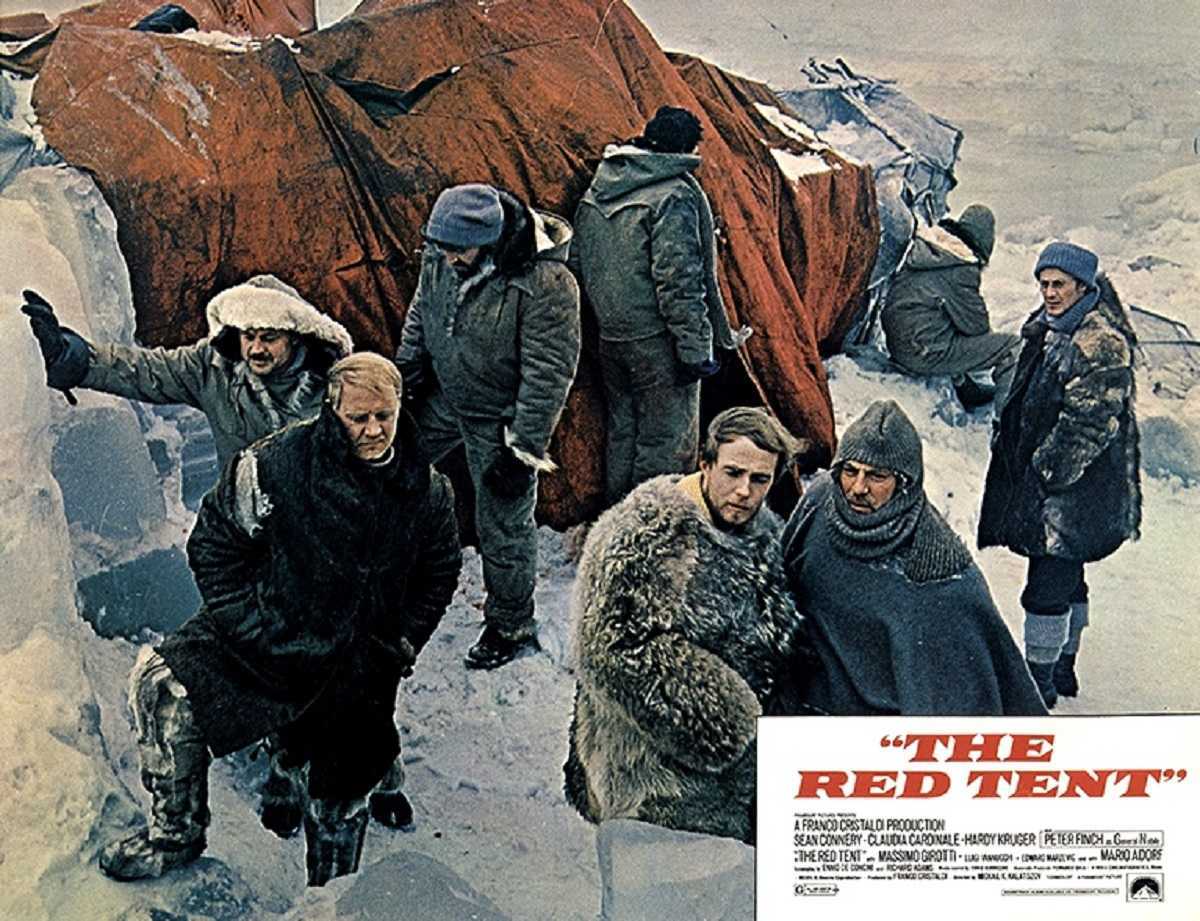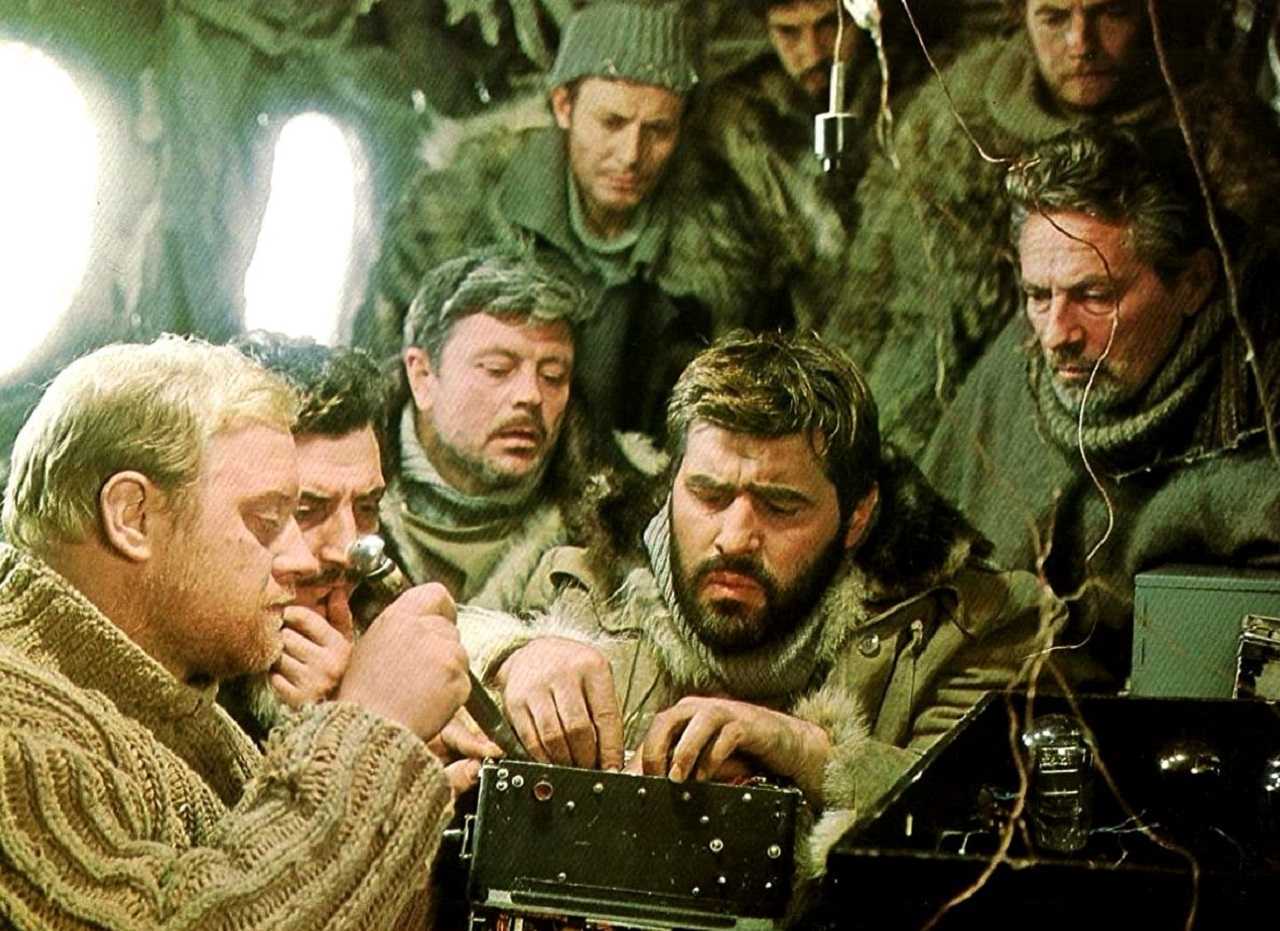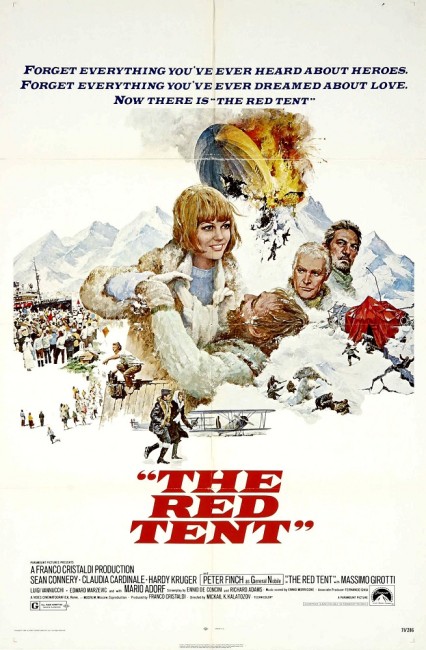Italy/USSR. 1969.
Crew
Director – Mickail K. Kalotozov, Screenplay – Richard Adams & Ennio De Concini, Producer – Franco Cristaldi, Photography – Leonid Kalashnikov, Music – Ennio Morricone, Art Direction – Giancarlo Bartolini Salimbeni & David Vinitsky. Production Company – Vides Cinematografica/Mosfilm.
Cast
Peter Finch (General Umberto Nobile), Sean Connery (Raoul Amundsen), Claudia Cardinale (Valeria), Edward Marzevic (Dr Finn Malmgren), Hardy Kruger (Einar Lundborg), Mario Adorf (Sergeant Guiseppe Biagi), Luigi Vanucchi (Captain Filippo Zappi), Massimo Girotti (Captain Romagna), Donatas Banionis (Mariano), Grigori Gaj (Samolovitch), Nikita Mikhalkov (Chuknovsky)
Plot
The aging General Umberto Nobile is unable to sleep and gathers to him the ghosts of those who were killed under his command to form a tribunal, asking them to judge his failure. He relives the events that occurred when he commanded the ill-fated expedition aboard the dirigible Italia in 1928 that set out to make the first crossing of the North Pole by air. The expedition quickly went awry as The Italia was caught by inclement weather and crashed on the icepack. Nobile and ten men survived and set up camp inside a tent that they painted red to attract attention of rescue parties. There they managed to subsist on their meagre supplies and by eating the meat of a polar bear they shot. However, the rescue mission was troubled by official dithering.
On the face of it, The Red Tent is not the most likely of films for inclusion here on a site devoted to fantastic films. It is a film that sets out to recreate the true-life events of the crash of the dirigible Italia in the Arctic in 1928. The expedition departed from King’s Bay on Spitsbergen Island in Norway with a sixteen man crew and successfully made the first aerial crossing of the North Pole. However, on the return journey, the airship was caught by a gale force wind. The exact causes of the crash are open to debate but the envelope was torn from the balloon (and has never been found), while the gondola crashed on the icepack with Nobile and nine others aboard. One of the men was killed but the nine others survived and spent 49 days on the icepack in a tent with meagre supplies scavenged from the crash.
What happened next is the subject of considerable controversy – Captain Romagna, the leader of the expedition’s base camp in King’s Bay, dithered over what to do, waiting for instructions from the Italian admiralty, who turned down multiple offers of help and failed to explore many avenues that would have affected a rescue. Even the base ship City of Milan failed to keep a watch for the radio signals that were coming. Roald Amundsen, the first man to reach the North Pole by foot, disappeared after leading a flight to find the crash. After being located, Nobile was flown out by the Swedish pilot Einar Lundborg on the 30th day, which became a cause of controversy over Nobile’s abandoning his men. The remaining survivors were eventually discovered by the Russian icebreaker Krasin and brought back to safety.
The Red Tent was a co-production between Italy and the USSR. The expedition has been reconstructed with highly impressive detail – the production team has built full-size airship interiors and there appear to be location shoots in real Arctic conditions and icepacks (actually in the Soviet Union). Ennio Morricone’s score is an appropriately noble and majestic one that soars right up across the ice along with the airship.

Russian director Mickail K. Kalozov wants to create an epic visual feel – like scenes of the airship in flight and the seat-edge crash sequence; the Russian icebreaker powering through the icecap and its crew lighting bonfires for the plane to land in the fog; or one sweeping vision with the peasant radio ham hanging on the end of a giant drawbridge. There are some fabulous aerial shots sweeping across the ice where we see polar bears and the tiny human figures below, which fully gives you an impression of just how vast an area it is that we are dealing with.
Kalozov doesn’t always carry it off – the film gets a little odd when it departs from the historic record and adds elements. The casting of then 39 year-old Scots Sean Connery as a 60+ year old Norwegian Roald Amunsden is bizarre, especially in that Amunsden was only 55 in 1928, not that far removed from Connery’s own age, which leaves the point of making him up some twenty years puzzling. Another of these is the need to write in a female love interest in the form of Claudia Cardinale (who was the mistress of one of the producers who insisted that she be placed into the story). Thus the opening is side-tracked by scenes of she and Edward Marzevic tumbling in the snow, while the historical record is awkwardly twisted out of shape in order to include her.
Certainly, you feel like the film skates over some of the issues that were involved in the Italia expedition. One of the things that is not mentioned is how Finn Malmgren made multiple attempts to commit suicide, believing that it was his advice regarding the weather that had led to the crashing of the expedition. The radio was set up hours after the crash whereas the film gives the impression that it was days. The biggest issue that seems swept under the carpet is the amount of sheer dithering that went on with Captain Romagna back in Spitsbergen who failed to move ships closer, set up radio monitoring and was overly reliant on the decisions being sent back and forth to the Italian admiralty who seemed indifferent about doing anything.

The film also makes a big thing out of how Valeria went to Amundsen and begged him to undertake a rescue mission but he initially refused her not wanting to go back to the Pole, whereas in reality Amundsen (a former colleague of Nobile) had volunteered to lead an expedition but was turned down by the Italian Navy. The film also has Amundsen dying at the site of the envelope crash after the plane crashed there whereas it is believed that his flight crashed at sea and to this date, despite extensive search, neither the wreckage of the envelope, the plane or the bodies from either the envelope or plane crash have been found.
The story of The Italia expedition and General Nobile is one surrounded by moral question marks. He was the subject of a smear campaign by rivals who sought to blacken his name. He was officially exonerated and yet when one digs beneath this, there are still some issues that make you think. To deal with these, the film constructs a wrap-around story set in the present-day where General Nobile forms a tribunal of ghosts to judge his actions whereby the events are allowed to play out as they are recounted.
Herein comes the fantasy element and the reason for The Red Tent‘s inclusion here. At the start, this seems a heavy-handed framing device, until the end where it is used to draw a very unusual and even movingly compassionate moral from the story. It is even more unusual when one considers that General Nobile, who didn’t die until 1978, was still alive at the time that The Red Tent was made.
The film is unrelated to and should not be confused with the subsequent Biblical tv mini-series The Red Tent (2014).
Trailer here


